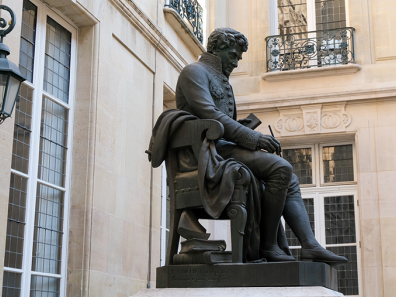Statue of Antoine-Isaac, Baron Silvestre de Sacy

The courtyard of the Maison de la Recherche houses the statue of Antoine-Isaac, Baron Silvestre de Sacy (1758-1838), a French linguist, philosopher and Arabist orientalist. Through his teaching and writings, he made a powerful contribution to the progress of Oriental studies, and trained a large number of students, both French and foreign, the most famous of whom was Jean-François Champollion.
The statue was created by two brothers, Louis and Charles Rochet, sculptors with an abundant output (including Charlemagne and the Leudes on the side of the forecourt of Notre Dame de Paris, a bas-relief depicting Africa on a balustrade in the Turgot wing of the Louvre, etc.). Fascinated by the study of Manchu and Mongolian, Louis Rochet joined the École des langues orientales vivantes in 1875 to teach these two languages. He asked for permission to erect a statue of Silvestre de Sacy, for whom he had great esteem, and set to work without waiting for approval from the Minister of Fine Arts. He died in January 1878, having produced a model in clay and with no idea that his project would be accepted. After his death, his brother Charles completed the project. The statue was delivered to the École in 1880. It escaped the requisition imposed in 1941.
In contrast to other establishments where the statue of the Founding Father was created thanks to a subscription by former students, the Silvestre de Sacy statue was financed by the State. The administrator (1824-1938) is faithfully depicted, dressed as a member of the Académie des Inscriptions et Belles Lettres and wearing the Légion d'Honneur. He is holding a manuscript and a quill pen, and books are shown under his seat.